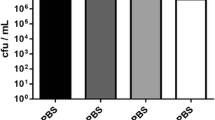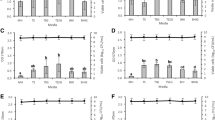Abstract
Today, methicillin-resistant Staphylococcus aureus (MRSA) is a feared cause of nosocomial infections worldwide. These organisms can gain increased resistance to antimicrobial agents through biofilm formation, which appears to be a bacterial survival strategy. MRSA isolates obtained from patients were cultured in nutrient-limited medium supplemented with 0.2% glucose in aerobic, anaerobic, and CO2 incubation atmospheres. Biofilm formation was quantified by the microtiter plate test. MRSA strains showed significantly lower biofilm production when grown in an aerobic atmosphere compared to that exhibited in CO2-rich environments. Gaseous conditions and growth in a nutritionally limited medium can profoundly influence the amount of biofilm formation in MRSA. This should be considered in any in vitro study of in vivo behavior.

Similar content being viewed by others
References
Ando E, Monden K, Mitsuhata R et al (2004) Biofilm formation among methicillin-resistant Staphylococcus aureus isolates from patients with urinary tract infection. Acta Med Okayama 58:207–214
Barker LP, Simpson WA, Christensen GD (1990) Differential production of slime under aerobic and anaerobic conditions. J Clin Microbiol 28:2578–2579
Christensen GD, Simpson WA, Younger JJ et al (1985) Adherence of coagulase-negative staphylococci to plastic tissue culture plates: a quantitative model for the adherence of staphylococci to medical devices. J Clin Microbiol 22:996–1006
Cramton SE, Ulrich M, Götz F et al (2001) Anaerobic conditions induce expression of polysaccharide intercellular adhesin in Staphylococcus aureus and Staphylococcus epidermidis. Infect Immun 69:4079–4085
Crump JA, Collignon PJ (2000) Intravascular catheter-associated infections. Eur J Clin Microbiol Infect Dis 19:1–8
Denyer SP, Davies MC, Evans JA et al (1990) Influence of carbon dioxide on the surface characteristics and adherence potential of coagulase-negative staphylococci. J Clin Microbiol 28:1813–1817
Donlan R, Costerton JW (2002) Biofilms: survival mechanisms of clinically relevant microorganisms. Clin Microbiol Rev 15:167–193
George RB (2000) Alveolar ventilation, gas exchange, and oxygen delivery. In: George RB, Light RW, Matthay MA, Matthay RA (eds) Chest medicine: essentials of pulmonary and critical care medicine, 4th edn. Lippincott Williams & Wilkins, New York, pp 44–55
Götz F (2002) Staphylococcus and biofilms. Mol Microbiol 43:1367–1378
Guiney DG (1997) Regulation of bacterial virulence gene expression by the host environment. J Clin Invest 99:565–569
Hall-Stoodley L, Costerton JW, Stoodley P (2004) Bacterial biofilms; from the natural environment to infectious diseases. Nat Rev Microbiol 2:95–108
Hussain M, Wilcox MH, White PJ et al (1992) Importance of medium and atmosphere type to both slime production and adherence by coagulase-negative staphylococci. J Hosp Infect 20:173–184
Pérez-Giraldo C, Rodríguez-Benito A, Morán FJ et al (1995) Influence of the incubation atmosphere on the production of slime by Staphylococcus epidermidis. Eur J Clin Microbiol Infect Dis 14:359–362
Stepanović S, Dakić I, Opavski N et al (2003) Influence of the growth medium composition on biofilm formation by Staphylococcus sciuri. Ann Microbiol 53:63–74
Stepanović S, Djukić V, Djordjević V et al (2003) Influence of the incubation atmosphere on the production of biofilm by staphylococci. Clin Microbiol Infect 9:955–958
Stepanović S, Vuković D, Dakić I et al (2000) A modified microtiter-plate test for quantification of staphylococcal biofilm formation. J Microbiol Methods 40:175–179
Reisner A, Krogfelt KA, Klein BM et al (2006) In vitro biofilm formation of commensal and pathogenic Escherichia coli strains: impact of environmental and genetic factors. J Bacteriol 10:3572–3581
Author information
Authors and Affiliations
Corresponding author
Rights and permissions
About this article
Cite this article
Uršič, V., Tomič, V. & Košnik, M. Effect of Different Incubation Atmospheres on the Production of Biofilm in Methicillin-Resistant Staphylococcus aureus (MRSA) Grown in Nutrient-Limited Medium. Curr Microbiol 57, 386–390 (2008). https://doi.org/10.1007/s00284-008-9211-z
Received:
Accepted:
Published:
Issue Date:
DOI: https://doi.org/10.1007/s00284-008-9211-z




